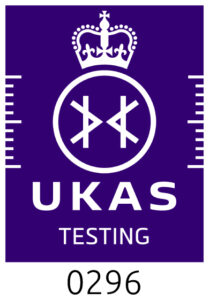The Acoustic Laboratory
The acoustics laboratory was purpose built in 1967 in order to meet the challenges posed by lightweight construction techniques.
ACOUSTICS
LEAD TIME – 2 WEEKS
TARGET REPORT TIME
5 WORKING DAYS
Notification of short-term test slot availability
The laboratory has a wall test suite, a floor test suite, and a reverberation room. The laboratory has over 40 years of experience and still leads the way in building acoustics excellence.
Sound Insulation
Sound insulation is the term which describes the reduction of sound which passes between two spaces separated by a dividing element.
In transmitting between two spaces the sound energy may pass through the dividing element (direct transmission) and through the surrounding structure (indirect or flanking transmission).
Therefore, in designing for sound insulation, it is important to consider both methods of transmission.
Flanking sounds reach the receiving or listening room by more devious paths than direct sounds.
The walls or floors which flank the dividing element constitute the main paths for flanking transmission, but these can also occur at open windows, heating or ventilation ducts, doorways into corridors and other sources of sound leakage.
The acoustic environment of the room and/or the building and the ability to reduce or eliminate air paths in the vicinity of the sound reducing element, e.g. doorsets, glazing, suspended ceiling cavities, ductwork, etc, will have a significant effect on its performance.
For these reasons, it is unlikely that the figures quoted from ideal test conditions will be achieved in practice. The sound insulation of walls and partitions only relate to the transmission of airborne sounds. These include speech, musical instruments, loudspeakers and other sounds, which originate in the air. In most cases, floors must also resist the transmission of impact sounds such as heavy footsteps and the movement of furniture.
Laboratory Sound Insulation Measurement
The laboratory is accredited for the following sound insulation test methods:
BS EN ISO 10140-2:2021 Acoustics – Laboratory measurement of sound insulation of building elements – Measurement of airborne sound insulation.
BS EN ISO 140-3:1995 Acoustic – Measurement of sound insulation in buildings and of building elements – Part 3 laboratory measurements of airborne sound insulation of building elements. (Withdrawn)
BS EN ISO 10140-3:2021 Acoustics – Laboratory measurement of sound insulation of building elements – Measurement of impact sound insulation
BS EN ISO 140-6:1998 Acoustic – Measurement of sound insulation in buildings and of building elements – Part 6 laboratory measurements of impact sound insulation of floors.
Site testing
The test centre offers a site sound insulation measurement service accredited by UKAS.
The site test facility is available to support the designer, owner or contractor who wishes to comply to Part E of the Building Regulations or new building techniques, or to occupiers wishing to demonstrate the level of sound insulation present within their property.
The method for measuring the field sound insulation of building elements is given in BS EN ISO 140-4:1998 and an additional method for measuring the impact sound insulation for floors is given in BS EN ISO 140-7:1998.
Once the sound reduction index has been measured the result can be rated to give single number figures and adaptation terms in accordance with BS EN ISO 717. The Building Test Centre has been conducting acoustic site testing for over thirty years and has the necessary skills and equipment in order to keep site disturbance to a minimum.
Sound Absorption Measurement
Sound absorption is the term given to the loss of sound energy on reflection at a surface. Sound absorbent surfaces are used to provide the correct acoustic climate in rooms. The choice of material will be influenced by its acoustic efficiency, appearance, durability and fire protection.
Sound absorption is principally used to control the acoustic response of a room so as to make the reverberation time of the space suitable for the function of the space.
The procedure for measuring the sound absorption by the reverberant room method is given in BS EN ISO 354:2003 (interrupted noise method only).

Get a quote today!
We’ll put together a customised quote about your project and work with you to get started on your project. Let’s build something together!
